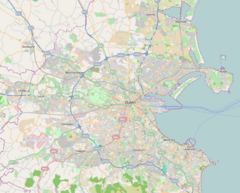
Ballsbridge is an affluent neighbourhood of the city of Dublin, the capital of Ireland. The area is largely situated north and west of a three-arch stone bridge across the River Dodder, on the south side of the city. The sign on the bridge still proclaims it as "Ball's Bridge", in recognition of the fact that the original bridge on that location was built and owned by the Ball family, a well-known Dublin merchant family in the 1500s and the 1600s. The current bridge was built in 1791.

Pembroke is a former local government area within County Dublin that was adjoining the city of Dublin, Ireland. It was formed as a township for local government purposes by a private act of Parliament in 1863. The township took its name from the fact that most of the area was part of the estate of the Earl of Pembroke. It was governed by town commissioners until 1899 when it became an urban district. In 1930 Pembroke was absorbed by the City and County Borough of Dublin.

3–31 Northgate Street is a terrace of shops, offices and a public house on the west side of Northgate Street, Chester, Cheshire, England. All the buildings have a set-back ground floor with a covered walkway, are timber-framed in their upper storeys, and are listed buildings, being graded II* or II. The part of the terrace comprising numbers 5–31 is known as Shoemakers' Row, or Sadler's Row.

Guiseley Theatre, formerly Guiseley Town Hall, is a municipal building at The Green, Guiseley, West Yorkshire, England. The structure, which was once the headquarters of Guiseley Urban District Council, is now a theatre.
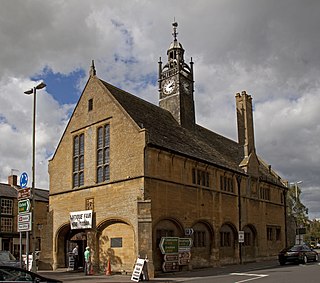
Redesdale Hall, also referred to as Moreton-in-Marsh Town Hall, is a municipal building in the High Street, Moreton-in-Marsh, Gloucestershire, England. The building, which is used as an events venue, is a Grade II listed building.

Meltham Town Hall is a municipal building in Carlile Street in Meltham, West Yorkshire, England. The building, which formerly operated as the offices of Meltham Urban District Council, is now The Crossroads Centre, which operates the local foodbank.

Kinross Town Hall forms part of a complex of municipal buildings in the High Street, Kinross, Perth and Kinross, Scotland. The town hall, which has been converted for residential use, is a Category B listed building.

Anstruther Town Hall is a municipal building in School Green, Anstruther Easter, Fife, Scotland. The structure, which is used as a community events venue, is a Category B listed building.

Denny Town House is a municipal building in Glasgow Road, Denny, Falkirk, Scotland. The structure is used by Falkirk Council for the provision of local services.

Pittenweem Parish Church and Tolbooth Steeple is an ecclesiastical and municipal complex in the High Street, Pittenweem, Fife, Scotland. The structure, which is used as the local parish church, is a Category A listed building.
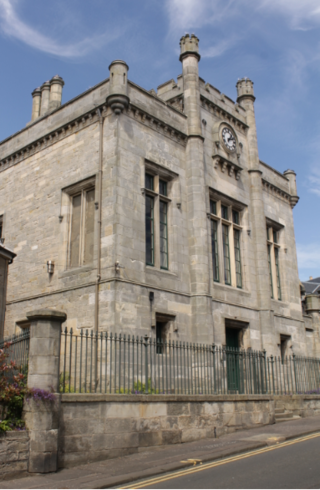
Kinghorn Town Hall is a municipal building in St Leonard's Place, Kinghorn, Fife, Scotland. The structure, which is used as holiday accommodation for tourists, is a Category B listed building.

County Buildings is a municipal structure in Drysdale Street, Alloa, Clackmannanshire, Scotland. The structure, which was the headquarters of Clackmannanshire County Council and is currently used as courthouse, is a Category B listed building.
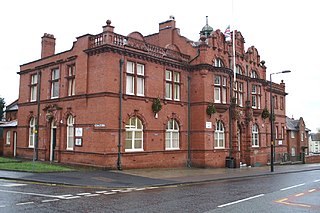
Ince-in-Makerfield Town Hall, also known as Ince-in-Makerfield Council Offices, is a municipal building in Ince Green Lane, Ince-in-Makerfield, Greater Manchester, England. The building is currently used as a children's nursery.

Ennis Town Hall is a municipal building in O'Connell Street, Ennis, County Clare, Ireland. The building accommodated the offices of Clonmel Urban District Council until 1965 but is now used as the banqueting suite of a local hotel.
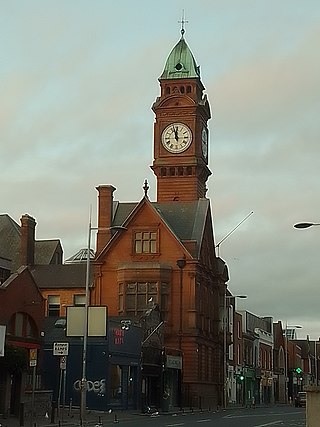
Rathmines Town Hall is a municipal building in Rathmines Road Lower, Rathmines, Dublin, Ireland. The building currently accommodates Rathmines College of Further Education.

Blackrock Town Hall, Library and Technical Institute, is a municipal complex in Main Road, Blackrock, Dublin, Ireland. The complex consists of a series of buildings formerly known individually as Blackrock Town Hall, Blackrock Library and Blackrock Technical Institute, but now accommodates the Blackrock Further Education Institute as well as an enlarged public library.
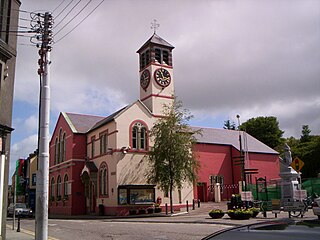
Skibbereen Town Hall is a municipal building in The Square at Skibbereen, County Cork, Ireland. It is currently used as a community events venue, hosting concerts and theatre performances.

Dalton Town Hall is a municipal building in Station Road, Dalton-in-Furness, a town in Cumbria, England. The building, which accommodates the offices and meeting place of Dalton-in-Furness Town Council, is a Grade II listed building.

Milnrow Town Hall, formerly known as Milnrow Council Offices, is a former municipal building in Newhey Road, Milnrow, a town in Greater Manchester in England. The building, which served as the offices and meeting place of Milnrow Urban District Council, is currently vacant.
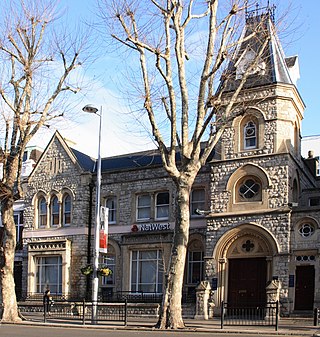
The Old Town Hall is a former municipal building in the Mall in Ealing, London. The building, which is currently used as a branch of National Westminster Bank, is a Grade II listed building.

